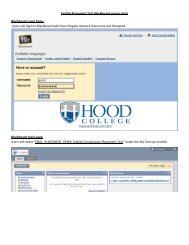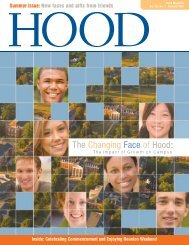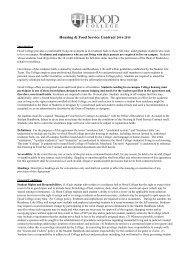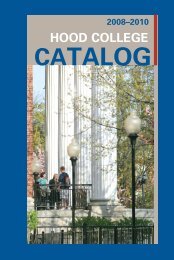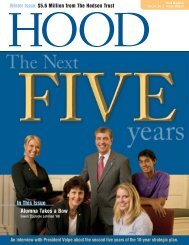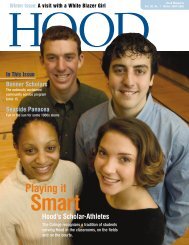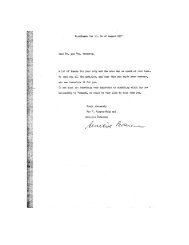Master of Arts in Humanities Student Handbook ... - Hood College
Master of Arts in Humanities Student Handbook ... - Hood College
Master of Arts in Humanities Student Handbook ... - Hood College
Create successful ePaper yourself
Turn your PDF publications into a flip-book with our unique Google optimized e-Paper software.
<strong>Master</strong> <strong>of</strong> <strong>Arts</strong> <strong>in</strong> <strong>Humanities</strong><strong>Student</strong> <strong>Handbook</strong> and Capstone Guidel<strong>in</strong>esAugust 2013
Table <strong>of</strong> ContentsPage• Introduction and Overview……………………………………………….. 3• Course <strong>of</strong> Study……………………………………………………………. 3• Foundation Courses……………………………………………………….. 3• Concentration……………………………………………………………… 4• Capstone…………………………………………………………………… 4• Required Forms…………………………………………………………… 13• Miscellaneous……………………………………………………………… 13• Samples……………………………………………………………………. 1 5• FormsDegree Candidacy Form (DCF)…………………………………… 26Concentration Agreement Form (CAF)…………………………. 27Capstone Proposal Cover Sheet………………………………….. 28Permission to Enroll Form (PTEF)……………………………... 29Capstone Title Page...............………………………………….. 31Petition to Graduate Form………………………………………. 322
IntroductionWelcome to the <strong>Master</strong> <strong>of</strong> <strong>Arts</strong> <strong>in</strong> <strong>Humanities</strong> program at <strong>Hood</strong> <strong>College</strong>. This handbook will help youunderstand the requirements specific to the <strong>Humanities</strong> program. Please refer to the <strong>Hood</strong> <strong>College</strong> Catalog forgeneral Graduate School policies.<strong>Student</strong>:Overview: The short Version1. Meets with faculty advisor to plan course <strong>of</strong> study, and registers for HUM 501 and 502, plusany additional courses <strong>of</strong> <strong>in</strong>terest;2. Meets with faculty advisor to plan concentration;3. Completes twelve or more credits;4. Fills out concentration agreement form and degree candidacy form (CAF and DCF), withfaculty advisor’s guidance, obta<strong>in</strong>s advisor’s signature, and submits signed forms to theprogram director;5. Completes rema<strong>in</strong><strong>in</strong>g coursework until s/he reaches 26 credits, at which po<strong>in</strong>t s/he is ready tobeg<strong>in</strong> the Capstone;6. Asks faculty member to advise Capstone;7. Asks two other faculty members to serve on Capstone committee;8. Develops Capstone proposal, <strong>in</strong> consultation with faculty advisor;9. Submits f<strong>in</strong>al Capstone proposal and properly formatted cover sheet to advisor andcommittee members for their approval signatures;10. Submits to Carolyn Korb (korb@hood.edu) --by first <strong>of</strong> the month—proposal and coversheet, and PTEF for HUM 595. NO proposals are reviewed <strong>in</strong> June or July;11. After MAHAC approves proposal, enrolls <strong>in</strong> HUM 595 and completes project (this generallytakes at least two semesters, or a summer and semester);12. Submits f<strong>in</strong>al project to advisor and committee members;13. Submits f<strong>in</strong>al project, with approval signatures <strong>of</strong> advisor and committee, to Graduate SchoolOffice;14. Sets up and participates <strong>in</strong> hour-long discussion <strong>of</strong> project with all committee members;15. Receives f<strong>in</strong>al grade on Capstone; and16. Graduates!The <strong>Master</strong> <strong>of</strong> <strong>Arts</strong> <strong>in</strong> the <strong>Humanities</strong> is a 30-credit <strong>in</strong>terdiscipl<strong>in</strong>ary degree program. It is designed primarilyfor <strong>in</strong>dividuals with a baccalaureate <strong>in</strong> art, history, literature, music, philosophy, and religion, although it alsoattracts students from areas outside <strong>of</strong> the humanities. It is <strong>in</strong>tended for students who would like to <strong>in</strong>tegratetheir particular expertise with corollary fields <strong>in</strong> the humanities.3
The curriculum rests on a three-stage structure. First, two foundational sem<strong>in</strong>ars—required <strong>of</strong> all students <strong>in</strong> theprogram—<strong>in</strong>troduce students to the idea <strong>of</strong> <strong>in</strong>terdiscipl<strong>in</strong>ary <strong>in</strong>quiry. These four credit-hour courses—HUM501, “<strong>Humanities</strong> and the Western Tradition, Part I,” and HUM 502, “<strong>Humanities</strong> and the Western Tradition,Part II”—<strong>of</strong>fer both a survey structure <strong>of</strong> Western civilization and a core theme.The core <strong>of</strong> the program is the Concentration, which comprises eighteen-credit hours. Each student, <strong>in</strong>consultation with an advisor, develops a plan <strong>of</strong> study for a cohesive Concentration <strong>of</strong> no fewer than twelvecredithours, or four courses. The Concentration can be historical, topical, or thematic.The f<strong>in</strong>al stage <strong>of</strong> the program is the Capstone Project (HUM 595), a four-credit experience <strong>in</strong>volv<strong>in</strong>g extended<strong>in</strong>dependent work, usually <strong>in</strong> the form <strong>of</strong> research and writ<strong>in</strong>g. The student works with a faculty advisor todevelop a topic and complete the project. Two other faculty members serve on the Project Committee.Plann<strong>in</strong>g the Course <strong>of</strong> StudyThe M.A. <strong>in</strong> <strong>Humanities</strong> <strong>of</strong>fers students great flexibility <strong>in</strong> design<strong>in</strong>g a course <strong>of</strong> study to meet their <strong>in</strong>terestsand goals. To take full advantage <strong>of</strong> that flexibility, however, it is important to beg<strong>in</strong> plann<strong>in</strong>g early.Foundation CoursesThe program rests on the foundation <strong>of</strong> two courses: HUM 501, “<strong>Humanities</strong> and the WesternTradition, Part I,” and HUM 502, “<strong>Humanities</strong> and the Western Tradition, Part II.” These courses are taught byfaculty from across the humanities; thus the core theme varies from semester to semester. There are nosubstitutes for these courses, and transfer credit will not be accepted as exemptions for HUM 501 or HUM 502.<strong>Student</strong>s are strongly encouraged to take either HUM 501 or HUM 502 before enroll<strong>in</strong>g <strong>in</strong> other graduatecourses, and to take both HUM 501 and HUM 502 early <strong>in</strong> the program. HUM 501 and HUM 502 <strong>in</strong>troducestudents to the rigor <strong>of</strong> graduate study and the idea <strong>of</strong> <strong>in</strong>terdiscipl<strong>in</strong>ary <strong>in</strong>quiry, and to the nature <strong>of</strong> research <strong>in</strong>the humanities. Tak<strong>in</strong>g these courses as you beg<strong>in</strong> your program also <strong>in</strong>troduces you to your peers and buildsrelationships that will be <strong>of</strong> great value as you move through the program. Additionally, most <strong>in</strong>structors <strong>in</strong>vitefaculty from discipl<strong>in</strong>es other than their own to meet with students <strong>in</strong> the course, which affords opportunities t<strong>of</strong>orge additional faculty relationships.The ConcentrationThe Concentration is the heart <strong>of</strong> the M.A. <strong>in</strong> <strong>Humanities</strong> program. <strong>Student</strong>s, <strong>in</strong> consultation with their advisor,design their own Concentration, a 12-hour credit-hour plan <strong>of</strong> study that def<strong>in</strong>es a clear, coherent, and cohesiveConcentration. The plan may take the form <strong>of</strong> historical concentration (Reformation Studies, RenaissanceStudies, American Studies) or may take a thematic or topical focus (Art and Ideology, The Representation <strong>of</strong>Women, Literature and Ethics). A comprehensive list <strong>of</strong> titles follows. <strong>Student</strong>s then choose other electives tomeet the eighteen-credit hour requirement.After complet<strong>in</strong>g twelve-credit hours <strong>in</strong> the program, students must complete two forms: the “DegreeCandidacy Form,” or DCF (page 30), and the “Concentration Agreement Form,” or CAF (page 31). The DCFcannot be completed without first submitt<strong>in</strong>g the CAF to the Program Director for approval. These forms aredue the first <strong>of</strong> every month for the follow<strong>in</strong>g months (note break over summer and <strong>in</strong> January): Aug, Sep, Oct,Nov, Dec, Feb, Mar, Apr, May. You will normally hear back from the Program Director by the end <strong>of</strong> themonth <strong>in</strong> which you submit the forms.4
On the CAF, the student lists the elective courses and provides the title for the Concentration. In review<strong>in</strong>g theCAF, the Program Director looks for evidence that the Concentration is clearly def<strong>in</strong>ed, coherent, and cohesive.Concentrations may consist <strong>of</strong> courses <strong>in</strong> only one discipl<strong>in</strong>e. However, beyond HUM 501 and 502, studentsmust take at least one course outside their discipl<strong>in</strong>e. Additionally, students may take no more than two nonhumanitiescourses (i.e., graduate courses <strong>in</strong> education, the social sciences, the natural sciences, or bus<strong>in</strong>ess) aselectives <strong>in</strong> the program. Before register<strong>in</strong>g for any non-humanities course, a student must petition the M.A. <strong>in</strong><strong>Humanities</strong> Advisory Committee (MAHAC), which will grant permission to register if the proposed course isclearly related to the student’s Concentration. <strong>Student</strong>s should submit forms requir<strong>in</strong>g the approval <strong>of</strong> theMAHAC to the program director and the Graduate Records Specialist well <strong>in</strong> advance <strong>of</strong> any Graduate Schooldeadl<strong>in</strong>e.Note: A student may devise a concentration that does not appear below. In that event, a short proposal is alsorequired along with the CAF and DCF; a sample concentration proposal appears on p. 15 <strong>of</strong> this document.It is critical that students beg<strong>in</strong> th<strong>in</strong>k<strong>in</strong>g about the Concentration as soon as they beg<strong>in</strong> the program. Indevelop<strong>in</strong>g a Concentration, students should consult the <strong>Hood</strong> <strong>College</strong> Catalog to explore the range <strong>of</strong>humanities courses <strong>of</strong>fered. It is important to remember that courses listed <strong>in</strong> the catalog are not <strong>of</strong>fered eachsemester or academic year.ACADEMIC CONCENTRATION TITLESAfrican American StudiesAmerican StudiesArchaeologyArt HistoryArt and LiteratureCommunication <strong>Arts</strong>Women's StudiesEnglish LiteratureEuropean StudiesFrench [German, Spanish, Arabic] StudiesGender StudiesHistoryLat<strong>in</strong> American StudiesMedieval and Renaissance StudiesMedieval StudiesMiddle Eastern StudiesMusicPhilosophyPhilosophy and ArtPhilosophy and LiteratureRace and EthnicityReligionReligion and ArtReligion and HistoryRenaissance Studies5
Guidel<strong>in</strong>es for <strong>Humanities</strong> Capstone Project (HUM 595)OverviewThe Capstone Project (HUM 595) is the culm<strong>in</strong>at<strong>in</strong>g experience <strong>of</strong> the M.A. <strong>in</strong> <strong>Humanities</strong>; each student <strong>in</strong> thedegree program must prepare a Capstone Project. It <strong>in</strong>volves extended <strong>in</strong>dependent work, usually <strong>in</strong> the form <strong>of</strong>research and writ<strong>in</strong>g, done <strong>in</strong> close collaboration with a faculty advisor and two other faculty members.The purpose <strong>of</strong> this requirement is to ensure that that the student understands the nature <strong>of</strong> research, hasmastered basic communication skills, can access and use the literature, and can th<strong>in</strong>k critically about asignificant problem. The literature should be reviewed with vigor, and discussions should reflect substantialthought and reason<strong>in</strong>g.The Capstone requires plann<strong>in</strong>g on the part <strong>of</strong> the student well <strong>in</strong> advance <strong>of</strong> the semester <strong>in</strong> which the studentwishes to enroll <strong>in</strong> HUM 595. <strong>Student</strong>s first develop a proposal <strong>in</strong> consultation with the project advisor, andwith the advisor’s assistance form a project committee, which consists <strong>of</strong> the project advisor and two otherfaculty members, or qualified <strong>in</strong>dividuals approved by the program director and the Dean <strong>of</strong> the GraduateSchool. All three members <strong>of</strong> the Capstone Committee must approve the proposal before the student submits itfor approval to the M.A. <strong>in</strong> <strong>Humanities</strong> Advisory Committee (MAHAC). (Further directions for this procedureare located below, under Adm<strong>in</strong>istrative Procedures; <strong>in</strong> the Capstone Guidel<strong>in</strong>es; and also on the CapstoneProposal Cover Sheet). Once the proposal is approved, the student submits a “Permission to Enroll” form to theGraduate School and formally enrolls <strong>in</strong> HUM 595.The proposal should be between three and six pages, and have approximately twenty sources. It shoulddescribe a project appropriate <strong>in</strong> scope, and one that can be completed <strong>in</strong> a timely manner. The proposal should<strong>in</strong>clude the follow<strong>in</strong>g:• a clear statement <strong>of</strong> the ma<strong>in</strong> research question;• a statement <strong>of</strong> the project’s hypotheses and arguments;• a brief discussion <strong>of</strong> the sources the student will consult <strong>in</strong> research<strong>in</strong>g the project, as well as a work<strong>in</strong>gbibliography;• the Capstone Proposal cover sheet (page 31) (not to be confused with the title page for the actualCapstone Project), available on the program’s webpage; and• a timetable for completion <strong>of</strong> the project.The proposal should be written with clarity and precision so it can be assessed by scholars outside <strong>of</strong> the ma<strong>in</strong>field <strong>of</strong> <strong>in</strong>quiry. It is expected that students will spend a significant amount <strong>of</strong> time on the organization andpreparation <strong>of</strong> this <strong>in</strong>itial proposal.The student and the project advisor will work together to develop and complete the project. Each Capstone willfollow its own path and trajectory based on the relationship between student and faculty advisor. It is advisablefor students to meet with their faculty advisor and discuss the project, and set down a process and schedule thatis mutually agreeable and <strong>in</strong> a manner that facilitates the completion <strong>of</strong> the project. The other members <strong>of</strong> thecommittee participate <strong>in</strong> approv<strong>in</strong>g the Capstone proposal, advis<strong>in</strong>g the student and grad<strong>in</strong>g the work.After submission <strong>of</strong> the f<strong>in</strong>al project, the student and the committee will meet for an hour-long discussion <strong>of</strong> thestudent's work. The Capstone is assigned a letter grade, which will reflect not only the quality <strong>of</strong> the f<strong>in</strong>alproduct, but also the student's performance throughout the project, <strong>in</strong>clud<strong>in</strong>g the culm<strong>in</strong>at<strong>in</strong>g discussion. If theproject is not completed <strong>in</strong> the first semester, the project advisor submits a grade <strong>of</strong> “IP” (<strong>in</strong>-progress) until theproject is completed and a f<strong>in</strong>al grade is submitted.6
The Capstone can be completed <strong>in</strong> a semester, assum<strong>in</strong>g that the student has enrolled <strong>in</strong> HUM 595 prior to thestart <strong>of</strong> the semester. Typically, however, the project will require two semesters, or a semester and summer, tocomplete. Regardless, it is essential that the student beg<strong>in</strong> plann<strong>in</strong>g for the Capstone Project—and mostimportantly, secur<strong>in</strong>g an advisor—well before the term <strong>in</strong> which it is to beg<strong>in</strong>. If necessary, the programdirectormay assist students <strong>in</strong> f<strong>in</strong>d<strong>in</strong>g an advisor for the Capstone.ExpectationsA Capstone Project <strong>in</strong> the form <strong>of</strong> a research paper is expected to be between fifty and eighty pages <strong>in</strong> length,exclusive <strong>of</strong> footnotes or other documentation. Draft<strong>in</strong>g and rewrit<strong>in</strong>g are <strong>in</strong>tegral components <strong>of</strong> the writtenresearch paper; further criteria will depend on the field and will be made clear by the advisor.Style<strong>Student</strong>s <strong>in</strong> the <strong>Humanities</strong> Program will follow the format and style such as that described <strong>in</strong> an establishedpublication manual appropriate to the humanities, such as the Modern Language Association or the ChicagoManual <strong>of</strong> Style. These manuals are available <strong>in</strong> the reference section <strong>of</strong> the <strong>Hood</strong> <strong>College</strong> Beneficial-HodsonLibrary, as well as <strong>in</strong> the <strong>Hood</strong> <strong>College</strong> Bookstore and other bookstores. The student and the advisor willdeterm<strong>in</strong>e which style guidel<strong>in</strong>es will be used. It is expected that the student will apply the guidel<strong>in</strong>esconsistently throughout the project. Of course, all forms <strong>of</strong> plagiarism, deliberate and accidental, areunacceptable. The student must understand thoroughly the acceptable methods <strong>of</strong> quot<strong>in</strong>g, paraphras<strong>in</strong>g, andcit<strong>in</strong>g sources. The aforementioned publication manuals discuss these issues clearly, and the student shouldwork closely with the advisor to ensure proper use <strong>of</strong> sources.ADMINISTRATIVE PROCEDURESCapstone Project AdvisorThe student is responsible for submitt<strong>in</strong>g a Capstone proposal to the MAHAC and for secur<strong>in</strong>g a Capstoneadvisor to oversee the project. If the proposed Capstone advisor is not a member <strong>of</strong> the <strong>Hood</strong> <strong>College</strong> faculty,the MAHAC must approve her or him. It is, <strong>in</strong> this case, the student's responsibility to forward a curriculumvitae and three letters <strong>of</strong> recommendation <strong>in</strong> support <strong>of</strong> the Capstone advisor to the program director prior to thestudent’s registration for HUM 595. If the Capstone advisor is on the faculty or staff <strong>of</strong> an accredited college oruniversity and is engaged <strong>in</strong> research, the MAHAC, if requested, may waive the requirement for three letters <strong>of</strong>recommendation. Advisors are approved by consent <strong>of</strong> the MAHAC. The MAHAC gives f<strong>in</strong>al approval <strong>of</strong> theCapstone proposal. It is expected that the Capstone advisor will hold the Ph.D. <strong>in</strong> the topic <strong>of</strong> Capstoneresearch.The Graduate Council <strong>of</strong> <strong>Hood</strong> <strong>College</strong> must approve a Capstone advisor who does not hold a term<strong>in</strong>al degree<strong>in</strong> his or her field. In such a case, the sponsor<strong>in</strong>g Program is asked to submit a curriculum vitae and three letters<strong>of</strong> recommendation <strong>in</strong> support <strong>of</strong> the Capstone advisor to the Dean <strong>of</strong> the Graduate School prior to the student’sregistration for HUM 595. The Graduate Council reviews credentials and recommends acceptance or rejection<strong>of</strong> the proposed advisor. F<strong>in</strong>al approval <strong>of</strong> the Capstone advisor is made by the Dean <strong>of</strong> the Graduate School,based upon the credentials <strong>of</strong> the proposed Capstone advisor and the recommendation <strong>of</strong> the Graduate Council.Register<strong>in</strong>g for Capstone Credits<strong>Student</strong>s writ<strong>in</strong>g a Capstone must register dur<strong>in</strong>g the regular graduate school registration period for coursenumber HUM 595, <strong>Humanities</strong> Research Project (4 credits). To register for the course, students must submit awritten proposal with signature <strong>of</strong> approval from their Capstone advisor and Capstone committee members(note the qualifications for Capstone advisor above) to Graduate Records Manager Carolyn Korb(korb@hood.edu), <strong>in</strong> the Graduate School <strong>of</strong>fice who will circulate the proposal to the MAHAC for review.Once approved by the MAHAC, the signatures from the program director and Dean <strong>of</strong> the Graduate Schoolmust be obta<strong>in</strong>ed. The approved proposal and required signatures will then be submitted to the Registrar’sOffice to complete the registration process.7
If the Capstone is not completed with<strong>in</strong> the same semester for which it was orig<strong>in</strong>ally registered, a grade <strong>of</strong> IP(In Progress) will be assigned until the Capstone has been completed to the satisfaction <strong>of</strong> the Graduate Schooland the <strong>Humanities</strong> Program.Project CommitteeThe approved Capstone advisor serves as the chair <strong>of</strong> the project committee. The advisor and the student, <strong>in</strong>consultation, will identify at least two additional persons to serve on the committee. At least one member <strong>of</strong> thecommittee must be a full-time equivalency (AC) faculty member <strong>in</strong> the sponsor<strong>in</strong>g program. Additionalmembers <strong>of</strong> the committee may be an AC faculty member <strong>in</strong> the degree program, another faculty member fromthe program, or another pr<strong>of</strong>essional work<strong>in</strong>g on the research topic. For non-members <strong>of</strong> the faculty, acurriculum vitae and one letter <strong>of</strong> recommendation must be submitted to the program director, who will reviewthe credentials and decide if the proposed candidate may sit on the project committee. The project committeemust all approve the Capstone Proposal, should be kept <strong>in</strong>formed <strong>of</strong> progress on the Capstone, and should meetas required to help guide the research.Discussion <strong>of</strong> ProjectA discussion <strong>of</strong> the Capstone among the project committee and the student is required, and will be conducted atan agreed upon date and at a specified location. After submission <strong>of</strong> the f<strong>in</strong>al project, the student and committeemembers will meet for an hour-long discussion <strong>of</strong> the student's work. At least two weeks before the discussionthe student should submit the Capstone, <strong>in</strong> f<strong>in</strong>al form, to the advisor, read<strong>in</strong>g committee members, the programdirector and the Dean <strong>of</strong> the Graduate School. The Dean <strong>of</strong> the Graduate School and the program director maybe <strong>in</strong>vited to attend the discussion, at the discretion <strong>of</strong> the advisor.Approval <strong>of</strong> <strong>Master</strong>'s CapstoneThe Capstone is approved after corrections recommended by the Capstone advisor and the project committeehave been completed. Signatures on the title page <strong>in</strong>dicate approval. (Names <strong>of</strong> <strong>in</strong>dividuals who sign the titlepage should be typed below the signature l<strong>in</strong>e.) F<strong>in</strong>al committee authorization and signatures <strong>of</strong> the programdirector and the Dean <strong>of</strong> the Graduate School are required before the Capstone is submitted to the library forb<strong>in</strong>d<strong>in</strong>g. Copies <strong>of</strong> the title page submitted to the Graduate School should bear orig<strong>in</strong>al signatures, notphotocopies.Grade for CapstoneThe Capstone advisor assigns a letter grade, which will reflect not only the quality <strong>of</strong> the f<strong>in</strong>al product, but alsothe student's performance throughout the project, <strong>in</strong>clud<strong>in</strong>g the culm<strong>in</strong>at<strong>in</strong>g discussion. A f<strong>in</strong>al grade <strong>of</strong> “F”on the Capstone usually results <strong>in</strong> the student's dismissal from the master's degree program.CAPSTONE REQUIREMENTS FOR ALL STUDENTSCopyrightUnder the Copyright Act <strong>of</strong> 1976, the "copyright <strong>in</strong> the work <strong>of</strong> authorship" becomes the property <strong>of</strong> the authorwho created it. For further <strong>in</strong>formation, please refer to the Copyright Office, Library <strong>of</strong> Congress, Wash<strong>in</strong>gton,DC 20559.<strong>Student</strong>s complet<strong>in</strong>g a Capstone must take care to obta<strong>in</strong> permission before us<strong>in</strong>g copyrighted materials with<strong>in</strong>their Capstone. Permission to use copyrighted materials, such as tables and figures, must be obta<strong>in</strong>ed from theholder <strong>of</strong> the copyright. The student needs to search carefully for the source <strong>of</strong> the copyright and obta<strong>in</strong>permission to use the copyrighted materials <strong>in</strong> the Capstone document. The permission to use copyrightedmaterials should be referenced <strong>in</strong> the Capstone at the po<strong>in</strong>t where such materials are presented. The studentmust reta<strong>in</strong> copies <strong>of</strong> the copyright permissions, and supply them to <strong>Hood</strong> <strong>College</strong> upon request. <strong>Student</strong>s8
complet<strong>in</strong>g a Capstone are able to facilitate the use <strong>of</strong> their Capstone research and f<strong>in</strong>d<strong>in</strong>gs by <strong>in</strong>clud<strong>in</strong>g acopyright waiver as part <strong>of</strong> the Capstone document.Copyright WaiverIn order to permit others to utilize the Capstone research and f<strong>in</strong>d<strong>in</strong>gs, the follow<strong>in</strong>g statement should appear <strong>in</strong>the Capstone on the page immediately follow<strong>in</strong>g the title page, with the head<strong>in</strong>g <strong>in</strong> standard format: “I doauthorize <strong>Hood</strong> <strong>College</strong> to lend this Capstone, or reproductions <strong>of</strong> it, <strong>in</strong> total or <strong>in</strong> part, at the request <strong>of</strong> other<strong>in</strong>stitutions or <strong>in</strong>dividuals for the purpose <strong>of</strong> scholarly research.” If you do not wish your work to be available toothers, the head<strong>in</strong>g should read “I do not authorize <strong>Hood</strong> <strong>College</strong> to lend this Capstone, or reproductions <strong>of</strong> it,<strong>in</strong> total or <strong>in</strong> part, at the request <strong>of</strong> other <strong>in</strong>stitutions or <strong>in</strong>dividuals for the purpose <strong>of</strong> scholarly research.”Acknowledgment <strong>of</strong> <strong>Hood</strong> <strong>College</strong> <strong>in</strong> Publications <strong>of</strong> Capstone WorkThe Graduate School <strong>of</strong> <strong>Hood</strong> <strong>College</strong> should be acknowledged <strong>in</strong> publications that result from the Capstoneresearch. A simple statement <strong>of</strong> acknowledgment is sufficient. An appropriate example would be "Researchreported <strong>in</strong> this document was orig<strong>in</strong>ally published <strong>in</strong> a master's degree Capstone sponsored by the Department<strong>of</strong> <strong>Humanities</strong> and submitted to The Graduate School <strong>of</strong> <strong>Hood</strong> <strong>College</strong> <strong>in</strong> Frederick, Maryland."Capstone Paper and Pr<strong>in</strong>t<strong>in</strong>g<strong>Student</strong>s will submit two copies <strong>of</strong> the Capstone. The orig<strong>in</strong>al copy <strong>of</strong> the Capstone for the <strong>Hood</strong> <strong>College</strong>Library should be on thesis paper, which is available from the <strong>Hood</strong> <strong>College</strong> Bookstore. The m<strong>in</strong>imumrequirement is a 20 lb., 25% rag or cotton content paper. The second copy is for the program director’s<strong>of</strong>fice. It may be a photocopy, and need only be placed <strong>in</strong> a black b<strong>in</strong>der, rather than be<strong>in</strong>g bound. Additionalcopies may be made at the discretion <strong>of</strong> the student. However, wait<strong>in</strong>g for the read<strong>in</strong>g committee's f<strong>in</strong>alapproval before produc<strong>in</strong>g multiple copies will help to avoid unnecessary expense. The Capstone should betyped or produced on a high quality pr<strong>in</strong>ter. A dot matrix pr<strong>in</strong>ter may not be used. Font sizes <strong>of</strong> 12 po<strong>in</strong>t arerequired for Capstone work. Standard typefaces should be used, either proportional or monospace. Justificationat the right marg<strong>in</strong> is optional. Reduction <strong>of</strong> tables or figures such that type size is smaller than 10 po<strong>in</strong>t is notacceptable.Head<strong>in</strong>gs, Spac<strong>in</strong>g, and Marg<strong>in</strong>sSection head<strong>in</strong>gs should conta<strong>in</strong> all uppercase letters, and be <strong>in</strong> boldface and centered at the top <strong>of</strong> a new page.All text must be double spaced with a left hand marg<strong>in</strong> <strong>of</strong> 1.5 <strong>in</strong>ches (3.8 cm.) and with right, top, and bottommarg<strong>in</strong>s <strong>of</strong> 1.0 <strong>in</strong>ch (2.5 cm.). The Graduate School will not accept Capstones that violate these marg<strong>in</strong>requirements.The one exception to this is on a "fac<strong>in</strong>g" legend page where the right marg<strong>in</strong> (adjacent to the sp<strong>in</strong>e) is 1.5<strong>in</strong>ches and the left marg<strong>in</strong> (toward the outer edge) is 1 <strong>in</strong>ch. The marg<strong>in</strong> requirements apply to all tables andfigures as well as pages with text. A fac<strong>in</strong>g figure legend page and the figure together have one page number.B<strong>in</strong>d<strong>in</strong>g and DistributionThe orig<strong>in</strong>al Capstone copy becomes the property <strong>of</strong> the <strong>Hood</strong> <strong>College</strong> Beneficial-Hodson Library. Theprogram director’s <strong>of</strong>fice reta<strong>in</strong>s the second copy for its files. Title pages for both <strong>of</strong> these copies must bearorig<strong>in</strong>al signatures (not photocopies) <strong>of</strong> the advisor, read<strong>in</strong>g committee members, program director, andGraduate School Dean. Additional copies may be bound at the student’s request for an additional fee. All f<strong>in</strong>alcopies are to be submitted to the Graduate School prior to the published deadl<strong>in</strong>e for each academic semester.The Graduate School will send one copy <strong>of</strong> the Capstone to the Library for b<strong>in</strong>d<strong>in</strong>g and archiv<strong>in</strong>g. Instructionsfor b<strong>in</strong>d<strong>in</strong>g and guidel<strong>in</strong>es for archiv<strong>in</strong>g have been published by the <strong>Hood</strong> <strong>College</strong> Beneficial-Hodson Libraryand are <strong>in</strong>cluded <strong>in</strong> this document. The student is responsible for all fees associated with the b<strong>in</strong>d<strong>in</strong>g andarchiv<strong>in</strong>g <strong>of</strong> their Capstone.9
Deadl<strong>in</strong>esThe importance <strong>of</strong> observ<strong>in</strong>g published deadl<strong>in</strong>es for f<strong>in</strong>al submission <strong>of</strong> the completed and approved Capstonecannot be overemphasized. <strong>Student</strong>s are urged to follow closely and carefully the published dates for Capstonesubmission. Arrangements for the oral defense <strong>of</strong> the Capstone should be made early enough to allow time forcompletion <strong>of</strong> required corrections. This will enable the candidate to earn the master's degree at the earliestpossible date. Past experience has shown that the most common reason for Capstone candidates to receive theirdiplomas later than anticipated is poor plann<strong>in</strong>g with respect to the deadl<strong>in</strong>es.As a general guidel<strong>in</strong>e, all Capstones are due <strong>in</strong> f<strong>in</strong>al form with signed cover pages to the Graduate School twoweeks prior to the last day <strong>of</strong> classes <strong>in</strong> the fall or spr<strong>in</strong>g semester. However, be sure to check the Catalog orcontact the Graduate School to confirm the assigned date each term.CAPSTONE GUIDELINES FOR MASTER’S DEGREE STUDENTS AT HOOD COLLEGEPrelim<strong>in</strong>ary pages or front matterAll <strong>of</strong> the below-named sections should beg<strong>in</strong> on separate pages and must be double-spaced. The prelim<strong>in</strong>arypages should be numbered <strong>in</strong> lower case Roman numerals located at the bottom center <strong>of</strong> each page. The titlepage is counted as page “i” but is not numbered. The prelim<strong>in</strong>ary pages should appear <strong>in</strong> the order specifiedbelow.a. Title page (see sample page <strong>in</strong> this document)b. Statement <strong>of</strong> Use and Copyright waiver (see example page)c. Abstractd. Dedication (this page is optional)e. Acknowledgements and Sponsorshipf. List <strong>of</strong> Tables – should <strong>in</strong>clude the page location <strong>of</strong> each table, and short legendsg. List <strong>of</strong> Figures – should <strong>in</strong>clude the page location <strong>of</strong> each Figure, and short legendsh. List <strong>of</strong> Abbreviations (optional)Ma<strong>in</strong> body <strong>of</strong> the textThe ma<strong>in</strong> body <strong>of</strong> the text should be numbered <strong>in</strong> Arabic numerals located at the bottom center <strong>of</strong> each page.The first page is counted as page “1” but is not numbered.Content SectionsIf you use section head<strong>in</strong>gs, they should be centered, capitalized, and should beg<strong>in</strong> on a new page. Contentsections are presented accord<strong>in</strong>g to the follow<strong>in</strong>g guidel<strong>in</strong>es:Cit<strong>in</strong>g sourcesRefer to the MLA <strong>Handbook</strong> or Chicago Style Manual, as stipulated <strong>in</strong> “Style” section.Title Page Signature Guidel<strong>in</strong>esNames <strong>of</strong> the <strong>in</strong>dividuals sign<strong>in</strong>g the title page should be typed <strong>in</strong> the space below their signature l<strong>in</strong>e, abovetheir title.10
∗ The cost to the author for b<strong>in</strong>d<strong>in</strong>g is $20.00 per copy. Multiple copies should be pre-sorted <strong>in</strong>tocomplete documents, so that each copy <strong>of</strong> your project has all <strong>of</strong> the requisite elements <strong>in</strong> its properplace. Materials submitted to the Library go out with the next b<strong>in</strong>dery shipment and are usually returnedto the Library with<strong>in</strong> five weeks <strong>of</strong> shipment. Payment for b<strong>in</strong>d<strong>in</strong>g is to be made to the GraduateSchool, and checks for b<strong>in</strong>d<strong>in</strong>g should be made payable to <strong>Hood</strong> <strong>College</strong>.∗ <strong>Student</strong>s should consider whether they will be <strong>in</strong> a position to pick up personal copies from the librarywhen the b<strong>in</strong>d<strong>in</strong>g is completed. If not, they can request that personal copies be mailed to them. There isa charge <strong>of</strong> $5.00 per copy for this service. Mail<strong>in</strong>g charges can be <strong>in</strong>cluded <strong>in</strong> the total for b<strong>in</strong>d<strong>in</strong>gservices, so only one check is necessary. As noted above, payment should be made to the GraduateSchool, with checks payable to <strong>Hood</strong> <strong>College</strong>.∗ Upon receipt from the b<strong>in</strong>dery, the Library's copy <strong>of</strong> the <strong>Master</strong>’s Project (Thesis, Mock Grant Proposal,Capstone, Field Work Project, or Independent Research Project) is cataloged under author, title, andappropriate subject entries. It is then shelved alphabetically by author's last name <strong>in</strong> the <strong>Master</strong>’s Projectsection and is available for use only <strong>in</strong> the Library.∗ If the student has ordered additional personal copies <strong>of</strong> the thesis or project, he or she will be notified byletter when the bound copies are received. It is expected that the student will pick the materials up fromthe library upon notification.12
FormsDegree Candidacy Form (DCF)(page 26)After you have completed twelve credit hours <strong>in</strong> the program, the Graduate School will notify you that youmust complete the Degree Candidacy Form. This should be done with your advisor. The form can be found onthe website (www.hood.edu/graduate). In addition to not<strong>in</strong>g the date on which you began the program and anytransfer credits, you must also attach a copy <strong>of</strong> your Concentration Agreement Form (see below). The DCFrequires the signatures <strong>of</strong> your academic advisor, the program director, and the Dean <strong>of</strong> the Graduate School.Concentration Agreement Form (CAF)(page 27)The Concentration Agreement must be approved by the MAHAC before you can submit the DCF to theGraduate School. On the CAF, please list the courses <strong>in</strong> the Concentration, both by course PREFIX-NUMBERand course title, and provide a brief description <strong>of</strong> the Concentration.You should submit the CAF to the Graduate Records Manager, Carolyn Korb (korb@hood.edu), who willdistribute it to the MAHAC.Petition to Graduate Form (page 32)<strong>Student</strong>s must complete and submit to the Graduate School Office the Petition to Graduate form by theestablished deadl<strong>in</strong>es posted to the <strong>College</strong>’s academic calendar, which is available onl<strong>in</strong>e atwww.hood.edu/graduate. To receive the Petition students must have their signed <strong>Master</strong>’s Degree CandidacyForm on file <strong>in</strong> the Graduate School Office and have completed a m<strong>in</strong>imum <strong>of</strong> 18 graduate credits toward theirprogram requirements. The Petition form <strong>in</strong>cludes <strong>in</strong>formation for those plann<strong>in</strong>g to complete their degreerequirements with<strong>in</strong> a year’s time.Directed Read<strong>in</strong>gs (HUM 550) and the Permission to Enroll Form(page 29)Up to six credit hours <strong>of</strong> <strong>in</strong>dependent study <strong>in</strong> the form <strong>of</strong> a Directed Read<strong>in</strong>gs course may count toward thedegree. You are responsible for arrang<strong>in</strong>g a Directed Read<strong>in</strong>gs course with an appropriate and will<strong>in</strong>g facultymember. Before you can enroll <strong>in</strong> HUM 550 you must file the Permission to Enroll Form with the GraduateSchool. This form requires the signatures <strong>of</strong> the course <strong>in</strong>structor, the program director, and the Dean <strong>of</strong> theGraduate School, as well as a written proposal that <strong>in</strong>cludes the course title, a description <strong>of</strong> the course, andidentifies the work (amount <strong>of</strong> read<strong>in</strong>g; number <strong>of</strong> meet<strong>in</strong>gs with <strong>in</strong>structor; number <strong>of</strong> written assignments andresearch) to be done <strong>in</strong> the course.MiscellaneousThis is not an exhaustive list; if you have questions, please call or email the program director.M.A. <strong>in</strong> <strong>Humanities</strong> Advisory Committee (MAHAC)The M.A. <strong>in</strong> <strong>Humanities</strong> Advisory Committee reviews and approves student proposals for Concentrations andCapstone Projects. It also advises the director, who chairs the committee, <strong>in</strong> sett<strong>in</strong>g program policies and goals.<strong>Student</strong>s who need to submit proposals for MAHAC’s approval should send them to the Graduate RecordsManager (Carolyn Korb, korb@hood.edu), who will then distribute them to MAHAC.13
York: CompuBibs, 1984.Brammer, Leila R. Excluded from Suffrage History: Matilda Joslyn Gage, N<strong>in</strong>eteenth-CenturyAmerican Fem<strong>in</strong>ist. Westport, Connecticut: Greenwood Press, 2000.Brown, Olympia, ed. Democratic Ideals: A Memorial Sketch <strong>of</strong> Clara B. Colby. N.p.: TheFederal Suffrage Association, 1917.Taylor, A. Elizabeth. “The Woman Suffrage Movement <strong>in</strong> Texas.” The Journal <strong>of</strong> SouthernHistory 17, no. 2 (May 1951): 194-215.Terbourg-Penn, Rosalyn. “African American Women and the Woman Suffrage Movement.” InOne Woman, One Vote: Rediscover<strong>in</strong>g the Woman Suffrage Movement. Edited by Marjorie SpruillWheeler, 135-155. Troutdale, Oregon: New Sage Press and Education Films, 1995.Thurner, Manuela. “‘Better Citizens Without the Ballot’: American Anti-Suffrage Women andTheir Rationale Dur<strong>in</strong>g the Progressive Era.” In One Woman, One Vote: Rediscover<strong>in</strong>g the WomanSuffrage Movement. Edited by Marjorie Spruill Wheeler, 203-220. Troutdale, Oregon: New Sage Pressand Education Films, 1995.III. Timetable for Completion <strong>of</strong> CapstoneMy goal is to complete this project dur<strong>in</strong>g the summer 2009 and fall 2009 semesters. I would like to completethe capstone and receive f<strong>in</strong>al approval from the advisory committee by December 2009. I would be happy tocomplete the project sooner, if possible. Below is a tentative schedule <strong>in</strong>dicat<strong>in</strong>g when certa<strong>in</strong> benchmarks forthe project will be met:April 2009May/June 2009July/August 2009September 2009October/November2009December 2009Receive approval from the M.A. <strong>in</strong> <strong>Humanities</strong> Advisory Committee formy Capstone Proposal.Identify possible primary and secondary sources and beg<strong>in</strong> acquir<strong>in</strong>g thosesources. Schedule a meet<strong>in</strong>g with advisor to discuss progress and anyconcerns.Complete <strong>in</strong>-depth research for capstone project. Beg<strong>in</strong> outl<strong>in</strong><strong>in</strong>g f<strong>in</strong>alpaper. Meet with advisor as necessary.Submit a complete rough draft <strong>of</strong> capstone project to advisor for review.Schedule meet<strong>in</strong>g with advisor to discuss any questions or concerns.Identify two prospective committee members to review Capstone.Notify program director, <strong>in</strong> writ<strong>in</strong>g, <strong>of</strong> advisory committee members.Revise rough draft. Meet with advisor as necessary to address anyconcerns.Submit f<strong>in</strong>al copy <strong>of</strong> capstone project to committee for approval. Meetwith advisory committee for f<strong>in</strong>al evaluation. Graduate!18
Capstone ProposalExample 2Capstone ProposalDebbie PettitM.A. <strong>in</strong> the <strong>Humanities</strong>October 2008The Last Frontier: A Family HistoryMy concentration <strong>in</strong> the Graduate Studies <strong>in</strong> <strong>Humanities</strong> program has focused on life <strong>in</strong> America,particularly that <strong>of</strong> women. The immigrant experience <strong>of</strong> Western Expansion, and the settlement <strong>of</strong> countryreferred to as the last frontier (Montana, Wyom<strong>in</strong>g, the Dakotas) <strong>in</strong> the early twentieth century, has a personal<strong>in</strong>terest because my maternal ancestors emigrated to America <strong>in</strong> 1913. To that end, <strong>in</strong> my Capstone Project(HUM 595) I propose to exam<strong>in</strong>e this experience as it relates to history as a whole, and my family <strong>in</strong> particular,by focus<strong>in</strong>g on the events, known as the push-pull factors, that led to the emigration <strong>of</strong> my family from Belgiumand Holland and their participation <strong>in</strong> the development and settlement <strong>of</strong> the area known as the Belgian Colony<strong>in</strong> northern Montana. I will also explore how this experience affected my female ancestors as they took part <strong>in</strong>this historical event.I plan to research the economic and cultural conditions that existed <strong>in</strong> the American West at the turn <strong>of</strong> thecentury as well as demonstrate the connection between the expansion <strong>of</strong> the American railway system, whichopened up these rema<strong>in</strong><strong>in</strong>g lands <strong>of</strong> the frontier to development, along with the government’s changes <strong>in</strong> theEnlarged Homestead Act <strong>of</strong> 1909 that facilitated this growth. In order to clarify the conditions that existed <strong>in</strong>Belgium and Holland at the time <strong>of</strong> my ancestors’ emigration, I will provide a brief overview <strong>of</strong> the historicalcircumstances <strong>in</strong> those countries. Along with this <strong>in</strong>formation, I will focus on the day-to-day existence <strong>of</strong> mygreat-grandmothers, which will illum<strong>in</strong>ate the personal lives <strong>of</strong> these immigrants, as well as add my femaleancestors’ voices to the slowly expand<strong>in</strong>g record <strong>of</strong> American women’s history.My sources for my research come from not only texts used for class work and research projects, but<strong>in</strong>terviews with family members, family documents, and their personal reflections. I plan to illustrate theproject with appropriate documents and photographs to highlight the environment and the experiences <strong>of</strong> myfamily and their fellow immigrants.Several books written about the female Western immigrant experience <strong>in</strong>clude personal diaries andreflections. One example <strong>of</strong> this type <strong>of</strong> resource is All But the Waltz: A Memoir <strong>of</strong> Five Generations <strong>in</strong> the Life<strong>of</strong> A Montana Family by Mary Clearman Blew. A useful example <strong>of</strong> an historical memoir, this book provides<strong>in</strong>formation about Montana dur<strong>in</strong>g the time period which I am exam<strong>in</strong><strong>in</strong>g. Another text I expect to be helpful isRefuge: An Unnatural History <strong>of</strong> Family and Place by Terry Tempest Williams because it is a f<strong>in</strong>e ancestralmemoir, as well as an <strong>in</strong>structive model <strong>of</strong> how to <strong>in</strong>tertw<strong>in</strong>e personal stories and the physical environmentwhere they took place. I will be referenc<strong>in</strong>g the necessary historical texts for the factual <strong>in</strong>formation perta<strong>in</strong><strong>in</strong>gto American, Belgium and Dutch history <strong>in</strong> order to support my exam<strong>in</strong>ation <strong>of</strong> the factors that <strong>in</strong>fluenced themigration <strong>of</strong> my family to the United States. I also plan to conduct research <strong>in</strong> the Pondera County and Montanahistorical archives <strong>in</strong> hopes <strong>of</strong> f<strong>in</strong>d<strong>in</strong>g <strong>in</strong>formation perta<strong>in</strong><strong>in</strong>g to the settlement <strong>of</strong> the Belgian Colony. Withthese resources, as well as family reflections and <strong>in</strong>terviews, particularly from my grandmother, whose parentsand husband were among the first immigrants to establish this area <strong>in</strong> Montana, I want to emphasize thesignificance <strong>of</strong> the <strong>in</strong>dividual lives <strong>of</strong> the women who were the backbone <strong>of</strong> their families and communities.Between the years 1840-1870, immigrants used covered wagons and oxen to cross the middle section <strong>of</strong> theU.S. and the Rocky Mounta<strong>in</strong> Range to settle along the west coast. This movement, known as the GreatMigration, is well documented, to <strong>in</strong>cludes many useful texts that describe women pioneers’ experiences,<strong>in</strong>fluences, and contributions to this historical event. Two works <strong>of</strong> this type are Wester<strong>in</strong>g Women and theFrontier Experience, 1800-1915 by Sandra L. Myres, and Pioneer Women: The Lives <strong>of</strong> Women on the Frontierby L<strong>in</strong>da Peavy and Ursula Smith. But the time period <strong>in</strong> which my ancestors emigrated to America, the yearsbetween 1900-1914, saw the largest number <strong>of</strong> foreign immigrants arrive <strong>in</strong> the history <strong>of</strong> America. Despite19
this momentous growth <strong>in</strong> population and settlement <strong>of</strong> the rema<strong>in</strong><strong>in</strong>g frontier, there has not been as much focusand documentation as seen with the earlier movement. Therefore, I look forward to be<strong>in</strong>g able to add to thehistorical record, <strong>in</strong> a small personal way, the voices <strong>of</strong> my family that were part <strong>of</strong> this momentous time <strong>in</strong>American history.I plan to beg<strong>in</strong> my work on this project <strong>in</strong> the spr<strong>in</strong>g semester <strong>of</strong> 2009, as I will have completed all requiredcourse work after this fall semester <strong>in</strong> 2008. I hope to be able to complete my work with<strong>in</strong> the spr<strong>in</strong>g semesteras well.Work<strong>in</strong>g BibliographyBlew, Mary Clearman. All But the Waltz: A Memoir <strong>of</strong> Five Generations <strong>in</strong> the Life <strong>of</strong>A Montana Family. Norman: University <strong>of</strong> Oklahoma Press, 1991.Hooker, Mark T. The History <strong>of</strong> Holland. Westport: Greenwood, 1999.Litz, Joyce. The Montana Frontier: One Woman’s West. Albuquerque: University <strong>of</strong>New Mexico Press, 2004.Kerber, L<strong>in</strong>da K. and Jane Sherron De Hart, eds. Women’s America: Refocus<strong>in</strong>g thePast. 6 th ed. New York: Oxford University Press, 2004.Malone, Michael P., Richard B. Roeder, and William L. Lang. Montana: A History <strong>of</strong>Two Centuries. Seattle: University <strong>of</strong> Wash<strong>in</strong>gton Press, 1991.Myres, Sandra L. Wester<strong>in</strong>g Women and the Frontier Experience: 1800-1915.Albuquerque: University <strong>of</strong> New Mexico Press, 1982.Norris, Kathleen. Dakota: A Spiritual Geography. Boston: Houghton Miffl<strong>in</strong>, 2001.Nugent, Walter. Cross<strong>in</strong>gs: The Great Transatlantic Migrations, 1870-1914.Bloom<strong>in</strong>gton: Indiana University Press, 1992.Peavy, L<strong>in</strong>da and Ursula Smith. Pioneer Women: The Lives <strong>of</strong> Frontier Women. Norman:University <strong>of</strong> Oklahoma Press, 1996.Raban, Jonathon. Bad Land: An American Romance. New York: V<strong>in</strong>tage, 1996.Stewart, El<strong>in</strong>ore Pruitt. Letters <strong>of</strong> a Woman Homesteader. Boston: Houghton Miffl<strong>in</strong>,1988.Van der Essen, Leon. A Short History <strong>of</strong> Belgium. Chicago: University <strong>of</strong> Chicago Press, 1920.Williams, Terry Tempest. Refuge: An Unnatural History <strong>of</strong> Family and Place. NewYork: V<strong>in</strong>tage, 1992.Woolf, Virg<strong>in</strong>ia. A Room <strong>of</strong> One’s Own. San Diego: Harcourt Brace, 1981.InterviewsAlcala, Martha Clara Habets Sabbe, grandmother. Interview by author.January 2009 (scheduled), Clarkdale, AZ.W<strong>in</strong>kelman, Ela<strong>in</strong>e Phyllis Sabbe, mother. Interview by author. 29 May 2008,Sparta, MI.MemoirsMilledge, Ann Habets. “Life <strong>in</strong> a Family <strong>of</strong> Seventeen.” Family documents <strong>of</strong> MarthaHabets Sabbe.20
Capstone ProposalExample 3Capstone ProposalElena CoelhoApril 2013Claude Cahun and C<strong>in</strong>dy Sherman:Unmask<strong>in</strong>g the Masquerade (?)“Under this mask is another,” Claude Cahun writes on a photomontage <strong>in</strong> her book Disavowals, “I willnever f<strong>in</strong>ish carry<strong>in</strong>g all <strong>of</strong> these faces.” 9 It is from this quote that the idea <strong>of</strong> writ<strong>in</strong>g my capstone under thescope <strong>of</strong> masquerade and performance theory sprung. By masquerade I mean an artificial identity that allowsan <strong>in</strong>dividual to act out gender roles <strong>in</strong> order to conform to normative values (shared values re<strong>in</strong>forced by asocial structure). The mask allows gender performance while also <strong>of</strong>fer<strong>in</strong>g a lens to exam<strong>in</strong>e the notion <strong>of</strong>gender identity. In addition, performance theory can be <strong>in</strong>terpreted as the means by which we act based uponour gender, through appearance, speech, gait, and ritual. In order for this to occur an audience/spectator isneeded even if the audience is oneself. Performance theory br<strong>in</strong>gs to light the fact that gender is not anessential, unchang<strong>in</strong>g state, and that the body and the ideology <strong>of</strong> normative value prescribe forcedgender/sexual roles. How is the fem<strong>in</strong><strong>in</strong>e represented <strong>in</strong> Claude Cahun and C<strong>in</strong>dy Sherman’s photography:through makeup and cloth<strong>in</strong>g, by enact<strong>in</strong>g certa<strong>in</strong> traits <strong>of</strong> passivity or through notions <strong>of</strong> essential, <strong>in</strong>natepersonalities? Explor<strong>in</strong>g masks <strong>of</strong> society through self-portrait photography opens a dialogue about the idea <strong>of</strong>the mask. Photography provides an important element <strong>in</strong> this analysis, s<strong>in</strong>ce Cahun and Sherman stage theirperformances before the camera lens that serves as both witness and collaborator for their acts. This blurred l<strong>in</strong>ebetween art and life creates a space for explor<strong>in</strong>g, through photography, the appearance <strong>of</strong> stereotypes and themore fluid quality <strong>of</strong> gender.By consider<strong>in</strong>g both Claude Cahun (1894-1954) and C<strong>in</strong>dy Sherman (b. 1954) together I seek toexam<strong>in</strong>e how and why they each employ masquerade dur<strong>in</strong>g different parts <strong>of</strong> the century as a critique <strong>of</strong>gender identity and sexual politics. This analysis utilizes visual evidence to demonstrate masquerade theorywhile also consider<strong>in</strong>g their images with<strong>in</strong> the context <strong>of</strong> their respective eras. Masquerade theory <strong>of</strong>fers a lensto view two artists from different times because it was concomitantly developed dur<strong>in</strong>g both eras, and thereforerepresents a theoretical l<strong>in</strong>k between the end <strong>of</strong> the 1920s and the 1970s. 10Cahun was a complicated artist work<strong>in</strong>g dur<strong>in</strong>g the first half <strong>of</strong> the twentieth century, one who<strong>in</strong>vestigated the notions <strong>of</strong> gender and identity. Born <strong>in</strong> France <strong>in</strong> 1894, Lucy Schwob later adopted thepseudonym Claude Cahun, <strong>in</strong>tentionally choos<strong>in</strong>g an androgynous name. 11 Her work ranges from photographyto photomontage, <strong>in</strong> addition to constructed puppets and semi-autobiographical writ<strong>in</strong>g. She published twobooks and several essays for political magaz<strong>in</strong>es. My focus will be on her photographic self-portraits from1925-1935, <strong>in</strong> which she <strong>in</strong>vestigates gender identity and sexual politics. With<strong>in</strong> these works she depicts herself<strong>in</strong> vary<strong>in</strong>g identities, sometimes mascul<strong>in</strong>e through short, cropped hair, other times as exaggeratedly fem<strong>in</strong><strong>in</strong>e,and also as androgynous, reach<strong>in</strong>g beyond gender (for example, see figure 1). Essentially, Cahun is try<strong>in</strong>g ondifferent identities by us<strong>in</strong>g her body as subject matter. By pos<strong>in</strong>g <strong>in</strong> an array <strong>of</strong> costumes and bend<strong>in</strong>g gender,she destabilizes the manner <strong>in</strong> which women are represented through her vary<strong>in</strong>g persona performed before thecamera. Work<strong>in</strong>g as a Surrealist artist, Cahun <strong>in</strong>corporates an aesthetic <strong>of</strong> dreams and false realities with<strong>in</strong> herconstructed portraits. Predat<strong>in</strong>g C<strong>in</strong>dy Sherman, she provides a start<strong>in</strong>g po<strong>in</strong>t for a discussion and comparison<strong>of</strong> two different artists <strong>in</strong>vestigat<strong>in</strong>g notions <strong>of</strong> gender. Both explore the l<strong>in</strong>e between fact and fiction bypresent<strong>in</strong>g complex personas.9 Claude Cahun, Disavowals or Cancelled Confessions, Trans. by Susan de Muth (Cambridge, Mass.: The MIT Press, 2007), 152.10 Performance art, also used throughout the 20 th century, would also fall under the lens <strong>of</strong> the masquerade.11 Cahun had several pseudonyms <strong>in</strong>clud<strong>in</strong>g Claude Courlis and Daniel Douglas. These names, <strong>in</strong> French, do not directly identify thegender <strong>of</strong> the person that seems to align well with her photographs. She began chang<strong>in</strong>g her name <strong>in</strong> c. 1919 after she beganphotograph<strong>in</strong>g herself, but before she depicted gender-bend<strong>in</strong>g images.21
C<strong>in</strong>dy Sherman, an artist who began her career <strong>in</strong> the 1970s, decades after Cahun, serves as an example<strong>of</strong> comparison. I will seek to l<strong>in</strong>k these two photographers conceptually by <strong>in</strong>vestigat<strong>in</strong>g their imagery underthe lens <strong>of</strong> the masquerade. Born <strong>in</strong> 1954, C<strong>in</strong>dy Sherman is an American artist from New Jersey who alsoutilizes self-portrait photography to explore gender identity. Sherman acts as model, photographer, andcostume and makeup designer. She alters herself and her surround<strong>in</strong>gs to create a myriad <strong>of</strong> characters fromHollywood starlet to art history pa<strong>in</strong>t<strong>in</strong>gs, and society portraits. By challeng<strong>in</strong>g accepted ideas <strong>of</strong> fem<strong>in</strong><strong>in</strong>ityand explor<strong>in</strong>g a range <strong>of</strong> personas, like Cahun, she too exam<strong>in</strong>es the notion <strong>of</strong> multiple identities and createsimagery that demonstrates how the female is perceived and the mask she must wear <strong>in</strong> order to fit with<strong>in</strong> theframework <strong>of</strong> a patriarchal society. By plac<strong>in</strong>g herself with<strong>in</strong> the context <strong>of</strong> advertis<strong>in</strong>g and filmrepresentations <strong>of</strong> women from the1950s and 1960s, Sherman destabilizes these fixed perceptions. My focus forSherman’s work perta<strong>in</strong>s specifically to her Untitled Film Stills from the late 1970s because it <strong>of</strong>fers an<strong>in</strong>terest<strong>in</strong>g parallel to Claude Cahun’s self-portraits <strong>in</strong> the way it exam<strong>in</strong>es the normative values <strong>of</strong> be<strong>in</strong>g awoman dur<strong>in</strong>g unstable times. 12Masquerade theory represents the central theme <strong>of</strong> this analysis and <strong>of</strong>fers a means <strong>of</strong> read<strong>in</strong>g theimagery through signs surround<strong>in</strong>g gender and sexuality. Joan Riviere, a British psychoanalyst who wrote andalso translated for Freud, published an essay on deal<strong>in</strong>g with gender and masquerade, writ<strong>in</strong>g this work thesame year women won the right to vote <strong>in</strong> England. Riviere, <strong>in</strong> her article from 1929, “Womanl<strong>in</strong>ess asMasquerade,” def<strong>in</strong>es the masquerade as “women who wish for mascul<strong>in</strong>ity may put on a mask <strong>of</strong> womanl<strong>in</strong>essto avert anxiety and the retribution feared from men.” 13 Written while Cahun was work<strong>in</strong>g, this essay supportsthe idea that the concept <strong>of</strong> performed masquerade existed dur<strong>in</strong>g Cahun’s time. Published dur<strong>in</strong>g the height <strong>of</strong>Cahun’s self-portraits, a cultural context for the emerg<strong>in</strong>g new woman may be established. Riviere’s writ<strong>in</strong>gmay be utilized to focus on C<strong>in</strong>dy Sherman’s work as well because Sherman’s photographs <strong>in</strong>vestigate clichéimages, ones <strong>in</strong>itially produced from a male perspective <strong>of</strong> the female ideal.Judith Butler, a poststructuralist philosopher contribut<strong>in</strong>g to fem<strong>in</strong>ist and queer theory, <strong>of</strong>fers apostmodern fem<strong>in</strong>ist perspective on masquerade and performance, a l<strong>in</strong>k that connects to Sherman. Butler pullsfrom Riviere’s article <strong>in</strong> her book Gender Trouble, a connection to Cahun’s time, analyz<strong>in</strong>g the idea <strong>of</strong> the mask<strong>of</strong> womanl<strong>in</strong>ess and gender as a cultural construct. 14 This book presents a complicated and at times confus<strong>in</strong>gread that Butler clarifies <strong>in</strong> The Judith Butler Reader where she seeks to speak for the marg<strong>in</strong>alized and notes aheterosexual hegemony. Butler states, “the reality <strong>of</strong> gender is also put <strong>in</strong>to crisis: it becomes unclear how todist<strong>in</strong>guish the real from the unreal…and what we <strong>in</strong>voke as the naturalized knowledge <strong>of</strong> gender is, <strong>in</strong> fact, achangeable and revisable reality.” 15 From a blend <strong>of</strong> these ideas a discussion <strong>of</strong> masquerade will be established.Both Cahun and Sherman produce photographs <strong>of</strong> personas that at first glance seem to be self-portraits,function<strong>in</strong>g <strong>in</strong> similar and vastly different ways. Cahun’s work depicts personal pieces that were seldomdisplayed. She cast herself <strong>in</strong> roles <strong>of</strong> mascul<strong>in</strong>e, hyper-fem<strong>in</strong><strong>in</strong>e, and androgynous portrayals. Gender andsexuality blend with<strong>in</strong> her work. Sherman’s film stills solely explore female roles, ones <strong>in</strong>spired by earlierfilms. Her work has always been meant for public exhibition, has been exhibited many times, and her imageslack the personal quality <strong>of</strong> Cahun’s. Both artists play with social stereotypes and the notion <strong>of</strong> normativegender values, Cahun through her vary<strong>in</strong>g identities and Sherman via reference to film imagery and stereotype.For example, Cahun’s Autoportrait from 1928 depicts a gender ambiguous figure <strong>in</strong> front <strong>of</strong> a mirror. Cahun,rather than gaz<strong>in</strong>g <strong>in</strong>to the mirror <strong>in</strong> a traditional expression <strong>of</strong> female vanity, confronts the viewer with herpierc<strong>in</strong>g gaze. Her cropped hair and upturned collar h<strong>in</strong>t at mascul<strong>in</strong>ity, but gender has become unclear with<strong>in</strong>this image. In comparison, C<strong>in</strong>dy Sherman’s Untitled Film Still #2 from 1977, presents Sherman also stand<strong>in</strong>g12 By this I mean that Cahun worked dur<strong>in</strong>g a time when French women fought for equality through vot<strong>in</strong>g rights (French womenwere unable to vote until 1944) and other <strong>of</strong>ficial <strong>in</strong>equalities, while Sherman’s film stills emerged dur<strong>in</strong>g second wave fem<strong>in</strong>ismfocus<strong>in</strong>g on <strong>in</strong>equalities such as reproductive rights, family issues and fair treatment with<strong>in</strong> the work force.13 Joan Riviere, “Womanl<strong>in</strong>ess as Masquerade.” In Formations <strong>of</strong> Fantasy, ed. by Victor Burg<strong>in</strong>, James Donald and Cora Kaplan(London: Methuen & Co., 1986), 35. The article was first published <strong>in</strong> The International Journal <strong>of</strong> Psychoanalysis, vol. 10, 1929.14 Butler, Judith, Gender Trouble, (New York: Routledge, 1990): 68-72.15 Judith Butler, “Bodily Inscriptions, Performative Subversions.” In The Judith ButlerReader, ed. by Sara Salih and Judith Butler (Oxford: Blackwell Publish<strong>in</strong>g, 2004), 100.22
<strong>in</strong> front <strong>of</strong> a mirror, she wears a blonde wig while hold<strong>in</strong>g a towel up to her body. Unlike Cahun, her gazerema<strong>in</strong>s unchalleng<strong>in</strong>g, she faces away from the viewer and gazes <strong>in</strong>to the mirror coquettishly, one handcaress<strong>in</strong>g her neck. We view from outside the room, further away from the scene than the close up <strong>in</strong> Cahun’swork. While these photographs address masquerade <strong>in</strong> different ways, Cahun through androgyny andconfrontation and Sherman through an overtly sensuous female stereotype, I argue that they both <strong>of</strong>fer examples<strong>of</strong> the performativity <strong>of</strong> the masquerade. Cahun’s masquerade rests with<strong>in</strong> her performance <strong>of</strong> what HavelockEllis called a third sex. While Cahun acts out and deconstructs the construct <strong>of</strong> gender through this maskSherman also acts out a stereotype as a Hollywood cliché. Sherman portrays a constructed character and thisrepresentation becomes the masquerade.I am <strong>in</strong>terested <strong>in</strong> the follow<strong>in</strong>g questions: 1) How do these artists <strong>in</strong>corporate masquerade <strong>in</strong>to theirimagery? 2) What effect do these masks leave upon the viewer? 3) How can one state that gender is constructedand produce this idea with<strong>in</strong> a photograph? 4) How does each artist perform masquerade, both through similarand contrast<strong>in</strong>g methods <strong>of</strong> portrayal? As stated above, my research beg<strong>in</strong>s with Riviere and Butler, though itcerta<strong>in</strong>ly will not adhere solely to their notions. I also will consider the writ<strong>in</strong>gs <strong>of</strong> Laura Mulvey and MaryAnn Doane who <strong>in</strong>vestigate film, the masquerade and scopophilia. Danielle Knafo, among other art historians,focuses on a psychoanalytic read<strong>in</strong>g <strong>of</strong> Cahun and to some extent Sherman as well.In conclusion, I seek to demonstrate that both Claude Cahun and C<strong>in</strong>dy Sherman <strong>of</strong>fer images that playwith the notion <strong>of</strong> gender and performativity, an important topic because it serves to <strong>in</strong>vestigate how identity isdictated by societal norms. My capstone beg<strong>in</strong>s with def<strong>in</strong><strong>in</strong>g the mask and the performativity <strong>of</strong> masquerade <strong>in</strong>addition to explor<strong>in</strong>g the notion <strong>of</strong> constructed gender. The body <strong>of</strong> my work rests with analyz<strong>in</strong>g the work <strong>of</strong>Cahun and then Sherman’s creat<strong>in</strong>g a dialog between the vary<strong>in</strong>g images. Through an analysis <strong>of</strong> these imagesI hope to connect the ideas <strong>of</strong> sexual politics and gender identity through the theory <strong>of</strong> masquerade, one thatforces the female subject to adorn an identity acceptable to a patriarchal system. Also, by consider<strong>in</strong>g theseworks I seek to demonstrate that these roles, while chang<strong>in</strong>g, still require a common critical lens with which toview them. My conclusions rema<strong>in</strong> to be formed, though I believe I will end with the question mark from mytitle.Timetable for CapstoneMarch 2013 – Complete Capstone Proposal and determ<strong>in</strong>e committee members. Obta<strong>in</strong>approval from the committee to submit proposal.April 2013 – Submit Capstone Proposal to the graduate school for approval.May 2013– After receiv<strong>in</strong>g authorization, register for HUM 595 for the Fall Semester.Summer 2013 – Cont<strong>in</strong>ue seek<strong>in</strong>g out research and add<strong>in</strong>g to my work<strong>in</strong>g bibliography.September 2013 – Focus on primary and secondary sources while utiliz<strong>in</strong>g notes to beg<strong>in</strong>writ<strong>in</strong>g an outl<strong>in</strong>e. Consult with advisor throughout this structur<strong>in</strong>g process.October 2013 – Prepare and f<strong>in</strong>alize the outl<strong>in</strong>e and then submit work to my capstone advisor.November 2013 – Beg<strong>in</strong> to organize my <strong>in</strong>troduction and determ<strong>in</strong>e, with advisor, that itconveys coherent thought.December 2013 – Beg<strong>in</strong> writ<strong>in</strong>g my rough draft and cont<strong>in</strong>ue to communicate with my advisor.January 2014 – Cont<strong>in</strong>ue writ<strong>in</strong>g my rough draft.February 2014 – F<strong>in</strong>ish the rough draft and submit to my advisor for comments.March 2014- Beg<strong>in</strong> f<strong>in</strong>al draft and submit by end <strong>of</strong> the month.April 2014- Correct the f<strong>in</strong>al draft.May 2014- Submit f<strong>in</strong>al draft for committee approval and meet for f<strong>in</strong>al evaluation.23
Work<strong>in</strong>g BibliographyButler, Judith. “Bodily Inscriptions, Performative Subversions.” In The Judith Butler Reader,ed. by Sara Salih and Judith Butler, 90-118. Oxford: Blackwell Publish<strong>in</strong>g, 2004.Gender Trouble. New York: Routledge, 1990.“Performative Acts and Gender Constitution: An Essay <strong>in</strong>Phenomenology and Fem<strong>in</strong>ist Theory.” Theatre Journal 40, no. 4 (1988):JSTOR.Cahun, Claude. Disavowals or Cancelled Confessions. Trans. by Susan de Muth.Cambridge, Mass.: The MIT Press, 2007.“Hero<strong>in</strong>es.” In Inverted Odysseys, ed. by Shelley Rice, 43-94.Cambridge, Mass: The MIT Press, 1999.Chadwick, Whitney. “An Inf<strong>in</strong>ite Play <strong>of</strong> Empty Mirrors: Women, Surrealism, and Self-Representation.” In Mirror Images: Women, Surrealism, and Self-Representation, ed. by Whitney Chadwick, 3-35.Cambridge, Mass.: The MIT Press, 1998.Cruz, Amanda, Smith, Elizabeth A.T., and Amelia Jones. C<strong>in</strong>dy Sherman: Retrospective.New York: Thames and Hudson, 1997.Doane, Mary Ann. “Film and the Masquerade: Theoriz<strong>in</strong>g the Female Spectator.”Screen 23, no. 3-4 (1982).Doy, Gen. Claude Cahun: A Sensual Politics <strong>of</strong> Photography. London: I.B. Tauris,2007.Jones, Amelia. “The ‘Eternal Return’: Self-Portrait Photography as a Technology <strong>of</strong>Embodiment.” Signs 27, no. 4 (2002): JSTOR.Kl<strong>in</strong>e, Katy. “In Or Out <strong>of</strong> the Picture: Claude Cahun and C<strong>in</strong>dy Sherman.” In MirrorImages: Women, Surrealism, and Self-Representation, ed. by Whitney Chadwick,66-81. Cambridge, Mass.: The MIT Press, 1998.Knafo, Danielle. “Claude Cahun: The Third Sex.” Studies <strong>in</strong> Gender and Sexuality 2,no. 1 (2001): JSTOR.Krauss, Rosal<strong>in</strong>d. C<strong>in</strong>dy Sherman: 1975-1993. New York: Rizzoli InternationalPublications, Inc., 1993.Latimer, Tirza True. “Act<strong>in</strong>g Out: Claude Cahun and Marcel Moore.” In don’t kiss me:The Art <strong>of</strong> Claude Cahun and Marcel Moore, ed. by Louise Downie, 56-71. London:Tate Publish<strong>in</strong>g, 2006.Liu, Jui-Chi’i. “Female Spectatorship and the Masquerade: C<strong>in</strong>dy Sherman’s UntitledFilm Stills.” History <strong>of</strong> Photography 34, no. 1 (2010).Mulvey, Laura. “A Phantasmagoria <strong>of</strong> the Female Body: The Work <strong>of</strong> C<strong>in</strong>dy Sherman.” NewLeft Review 188, (July/August 1991).“Visual Pleasure and Narrative C<strong>in</strong>ema.” Orig<strong>in</strong>ally Published- Screen16, no.3 (1975): 6-18.http://imlportfolio.usc.edu/ctcs505/mulveyVisualPleasureNarrativeC<strong>in</strong>ema.pdf .Oehsen, Krist<strong>in</strong>e. “The Lives <strong>of</strong> Claude Cahun and Marcel Moore.” In don’t kiss me:The Art <strong>of</strong> Claude Cahun and Marcel Moore, ed. by Louise Downie, 10-23.London: Tate Publish<strong>in</strong>g, 2006.Resp<strong>in</strong>i, Eva. C<strong>in</strong>dy Sherman. New York: The Museum <strong>of</strong> Modern Art, 2012.Riviere, Joan. “Womanl<strong>in</strong>ess as Masquerade.” In Formations <strong>of</strong> Fantasy, ed. by VictorBurg<strong>in</strong>, James Donald and Cora Kaplan 35-44. London: Methuen & Co., 1986.Solomon- Godeau, Abigail. “The Equivocal ‘I’: Claude Cahun as Lesbian Subject.” InInverted Odysseys, ed. by Shelley Rice, 111-125. Cambridge, Mass.: The MIT Press,1999.Stevenson, James. “Claude Cahun: An Analysis <strong>of</strong> Her Photographic Technique.” In don’t kissme: The Art <strong>of</strong> Claude Cahun and Marcel Moore, ed. by Louise Downie, 46-55. London: Tate Publish<strong>in</strong>g, 2006.Tashjian, Dickran. “Vous Pour Moi? Marcel Duchamp and Transgender Coupl<strong>in</strong>g.” InMirror Images: Women, Surrealism, and Self-Representation, ed. by WhitneyChadwick, 37-65. Cambridge, Mass.: The MIT Press, 1998.Williamson, Judith. “Images <strong>of</strong> C<strong>in</strong>dy Sherman.” Screen 24, no. 6 (November/December 1983).24
COPYRIGHT LETTER EXAMPLEDateHolder <strong>of</strong> CopyrightStreet AddressCity, State ZipDear Holder <strong>of</strong> Copyright:I am a graduate student <strong>in</strong> the <strong>Arts</strong> <strong>Master</strong>'s degree program at <strong>Hood</strong> <strong>College</strong> <strong>in</strong> Frederick Maryland. MyCapstone is __________. I am request<strong>in</strong>g permission to <strong>in</strong>clude <strong>in</strong> my Capstone the follow<strong>in</strong>g material:(Include all relevant <strong>in</strong>formation about your request: title, page numbers, year <strong>of</strong> publication, etc.)If permission is granted, proper acknowledgement and credit will be <strong>in</strong>corporated <strong>in</strong> the Capstone document.S<strong>in</strong>cerely,Your NameContact Information25
<strong>Hood</strong> <strong>College</strong><strong>Master</strong> <strong>of</strong> <strong>Arts</strong> <strong>in</strong> the <strong>Humanities</strong>DEGREE CANDIDACY FORMPr<strong>in</strong>t Name_________________________________________ <strong>Student</strong> ID No. ______________________________Day Phone _______________________________________Eve. Phone____________________________________E-mail Address____________________________________________________________________________________Street ____________________________________________________________________Apt.____________City, State, ZIP_____________________________________________________________________________________1. Date <strong>of</strong> first course <strong>in</strong> the program_________. Date <strong>of</strong> expiration <strong>of</strong> seven-year time limit (see catalog) __________.2. Please <strong>in</strong>dicate courses (6 credit maximum) approved for transfer by the Dean <strong>of</strong> the Graduate School. Officialtranscript(s) and course description(s) or syllabus(i) must be on file <strong>in</strong> the Graduate School before this formcan be submitted. Indicate the department number, course number, course title, credits earned, date completed,<strong>in</strong>stitution and grade(s) earned. Please read the section <strong>of</strong> the <strong>Hood</strong> <strong>College</strong> Catalog regard<strong>in</strong>g transfer <strong>of</strong> credit forfull details <strong>of</strong> the transfer policy.__________________________________________________________________________________________________________________________________________________________________________________________________________________________________________________________________________________________3. Put a CHECKMARK by the courses listed that you have satisfactorily completed at <strong>Hood</strong>. CIRCLE the courses <strong>in</strong>which you are currently enrolled or plan to take. Fill <strong>in</strong> the details where <strong>in</strong>dicated. Place a “T” by courses you listedfor transfer <strong>in</strong> section number two (2) above.Sem<strong>in</strong>ars (No transfers allowed): ____HUM 501 ____HUM 502Elective Courses: Place a “C” after the four courses that def<strong>in</strong>e the concentration1. ___________________2. ___________________3. ___________________4. ___________________5. ___________________6. ___________________Capstone: ____HUM 595 * * Requires Permission to Enroll Form4. CONCENTRATION AGREEMENT FORM: Please attach the Concentration Agreement Form for review andapproval. The Graduate School Office will keep an approved copy for the <strong>of</strong>ficial student file.5. SIGNATURES: The student is responsible for obta<strong>in</strong><strong>in</strong>g signatures from the advisor and department chair before theform is submitted to the Dean. Do not mail this form to your advisor. You MUST schedule an appo<strong>in</strong>tment with youradvisor to complete this form together.<strong>Student</strong>________________________________________________________________ Date______________________Advisor________________________________________________________________ Date______________________Program Director________________________________________________________ Date______________________Dean__________________________________________________________________ Date______________________Copies: Graduate Office, Advisor and Candidate26
<strong>Hood</strong> <strong>College</strong><strong>Master</strong> <strong>of</strong> <strong>Arts</strong> <strong>in</strong> the <strong>Humanities</strong>CONCENTRATION AGREEMENT FORMCandidate’s Name: __________________________________________________________________________________Day Phone: _______________________________________ Even<strong>in</strong>g Phone:____________________________________E-mail Address:_____________________________________________________________________________________Advisor’s Name:______________________________________Extension: _____________________________________Title <strong>of</strong> Concentration: ____________________________________________________________________________________________________________________________________________________________________________Courses <strong>in</strong> Concentration (must be a m<strong>in</strong>imum <strong>of</strong> four courses/12 credit hours; for directed read<strong>in</strong>gs, <strong>in</strong>dependentstudies, and HUM Colloquium courses, give full course title):1. _______________________________________________________________________________________________2. _______________________________________________________________________________________________3. ________________________________________________________________________________________________4. ________________________________________________________________________________________________5. ________________________________________________________________________________________(optional)6. ________________________________________________________________________________________(optional)Action <strong>of</strong> the Program Director:_____ ACCEPTProgram Director’s Signature: ___________________________________________________ RETURN for reassessment; comments below:____________________________________________________________________________________________________________________________________________________________________________________________________∗ Please submit this CAF to the Program Director (Amy Gottfried; gottfried@hood.edu).∗ Concentration proposals will be due the first <strong>of</strong> every month for the follow<strong>in</strong>g months (note thebreak over the summer and <strong>in</strong> January): Aug, Sep, Oct, Nov, Dec, Feb, Mar, Apr, May.∗ You will normally hear back from MAHAC by the end <strong>of</strong> the month <strong>in</strong> which you submit thisproposal.Copies: Graduate School, Advisor and Candidate27
<strong>Hood</strong> <strong>College</strong><strong>Master</strong> <strong>of</strong> <strong>Arts</strong> <strong>in</strong> the <strong>Humanities</strong>CAPSTONE PROPOSAL COVER SHEETThis form must be attached to the front <strong>of</strong> the Capstone Proposal.Candidate Name: ________________________________________________________Day Phone: _______________________Eve. Phone:_________________________Email Address: ______________________________________________Concentration with<strong>in</strong> the M.A.:______________________________________________Proposed Title <strong>of</strong> Capstone: ______________________________________________Academic Discipl<strong>in</strong>e(s) <strong>of</strong> Capstone: ________________________________________Advisor <strong>of</strong> Capstone: _____________________________________________________Advisor’s Approval Signature: ____________________________________________________Committee Members Approval Signatures: __________________________________________________________________________________________Anticipated Graduation Date: ______________________________________________Please attach double-spaced proposal, along with work<strong>in</strong>g bibliography. Capstone proposals should be betweenthree and six pages long, and must be <strong>in</strong> narrative, not outl<strong>in</strong>e, form. Work<strong>in</strong>g bibliographies should have atleast twenty sources.Sample proposals may be found <strong>in</strong> the Graduate <strong>Student</strong> <strong>Handbook</strong> and Capstone Guidel<strong>in</strong>es.∗ ALL committee members must approve and sign <strong>of</strong>f on this proposal before MAHAC will reviewit. Approval may be sent via e-mail to korb@hood.edu <strong>in</strong> lieu <strong>of</strong> a signature.∗ Capstone proposals will be due the first <strong>of</strong> every month for the follow<strong>in</strong>g months (note the breakover the summer and <strong>in</strong> January): Aug, Sep, Oct, Nov, Dec, Feb, Mar, Apr, May.∗ You will normally hear back from MAHAC by the end <strong>of</strong> the month <strong>in</strong> which you submit thisproposal. F<strong>in</strong>al copies <strong>of</strong> Capstones with signed cover sheets are due at the Graduate Officeusually two weeks before the last day <strong>of</strong> classes: check with the Graduate School Office for specificdates.28
*Beg<strong>in</strong>n<strong>in</strong>g Fall 2008, the Graduate School will cont<strong>in</strong>ue to re-register students each semester for fieldwork/research projects as “IP” (In Progress) until a f<strong>in</strong>al grade is submitted. <strong>Student</strong>s are responsible to pay theGraduate School comprehensive fee each fall and spr<strong>in</strong>g semester until the project is completed.#<strong>Student</strong>s who enroll <strong>in</strong> a thesis must also submit a signed cover sheet with this form and the written proposal.+<strong>Student</strong>s who enroll <strong>in</strong> a 6-credit project or course will be registered and billed for all six credits <strong>in</strong> onesemester. Credits will not be split over the course <strong>of</strong> multiple semesters.THE TITLE FOR THE ABOVE ENROLLMENT IS:THE ATTACHED WRITTEN PROPOSAL FOR THIS PROJECT/INDEPENDENT STUDY WASAPPROVED BY:<strong>Student</strong>’s Signature:Date:Instructor’s Name (pr<strong>in</strong>ted):Instructor’s Signature:Program Director:Dean <strong>of</strong> the Graduate School:Date:Date:Date:Copies: Registrar, <strong>Student</strong>, Instructor, <strong>Student</strong> File, Graduate School Office Manager30
Sample Title PageTHE USE OF THE VIRGIN MARY IN MEDIEVAL GERMAN ALTAR PIECESbyMarjorie SmithB.A. (University <strong>of</strong> Maryland) 1983CAPSTONESubmitted <strong>in</strong> partial satisfaction <strong>of</strong> the requirementsfor the degree <strong>of</strong>MASTER OF ARTS<strong>in</strong>HUMANITIES<strong>in</strong> theGRADUATE SCHOOL<strong>of</strong>HOOD COLLEGEMay 2010Accepted:______________________(Type Name)Committee Member______________________(Type Name)Committee Member_______________________(Type Name)Capstone Advisor__________________________(Type Name)Program Director________________________Maria Green Cowles, Ph.D.Dean <strong>of</strong> the Graduate School31
PETITION TO GRADUATESAMPLE ONLY Please use l<strong>in</strong>k at the bottom<strong>of</strong> this page for a current form from our website. If you planto graduate <strong>in</strong> January, May or September 2010 or January 2011, please complete the bottom portion <strong>of</strong> this form andreturn it to the Graduate School Office by the dates listed below.Please note that you must complete this form <strong>in</strong> order for a diploma to be ordered for you, and to allow your name to bepresented to the faculty and Board <strong>of</strong> Trustees for approval. The dates for Board <strong>of</strong> Trustees and faculty meet<strong>in</strong>gs havealready been set and there will be no exceptions to the deadl<strong>in</strong>es below. It is imperative that you clearly pr<strong>in</strong>t yourname as you wish it to appear on your diploma. Candidates who graduate <strong>in</strong> the previous September and January are<strong>in</strong>vited to participate <strong>in</strong> the follow<strong>in</strong>g May Commencement Ceremony. Information regard<strong>in</strong>g the May ceremony will bemailed <strong>in</strong> early April.To be considered for graduation you must have an approved Degree Candidacy Form (DCF) on file <strong>in</strong> the GraduateSchool <strong>of</strong>fice. If you have not completed a DCF, please contact your advisor to complete it as soon as possible.ANTICIPATED GRADUATION DATE PETITION DUE DATEJanuary 15, 2010 September 7, 2009May 22, 2010 December 14, 2009September 15, 2010 February 5, 2010January 15, 2011 September 5, 2010PROPOSED DATE OF GRADUATION (choose one):January 15, 2010 May 22, 2010 September 15, 2010 January 15, 2011Will you participate <strong>in</strong> Commencement Exercises? (This form <strong>in</strong> no way commits you to participate.)YesPlease pr<strong>in</strong>t your name as you wish it to appear on your diploma: SAMPLE ONLYPlease use l<strong>in</strong>k at the bottom <strong>of</strong> this page for a current form from our website.NoSocial Security Number: __________________________________________________________________Home Address: ______________________________________________________________________________________________________________________________________________________________________________________Daytime Telephone Number: _________________________________________________________________________Even<strong>in</strong>g Telephone Number: _________________________________________________________________________E-mail Address: ___________________________________________________________________________________Degree Program and Concentration: ____________________________________________________________________<strong>Hood</strong> <strong>College</strong> Graduate School · 401 Rosemont Avenue · Frederick, MD 21701-8575Tel. 301-696-3600 · 800-922-1599 · Fax 301-696-3597 · E-mail hoodgrad@hood.edu · www.hood.edu/graduatePlease use this l<strong>in</strong>k for current form .http://www.hood.edu/documents/pdf/grad_petition_to_graduate.pdf32




